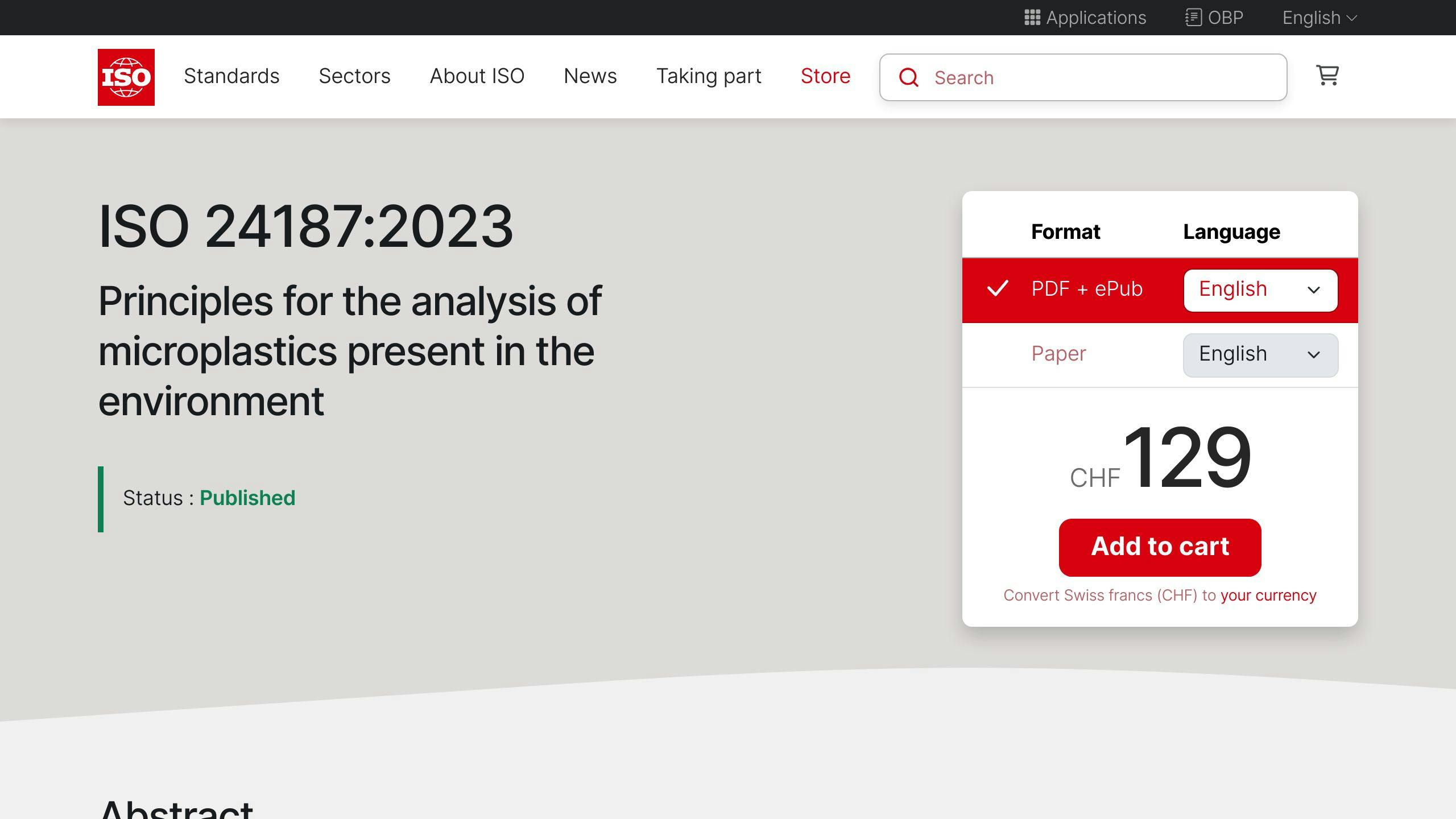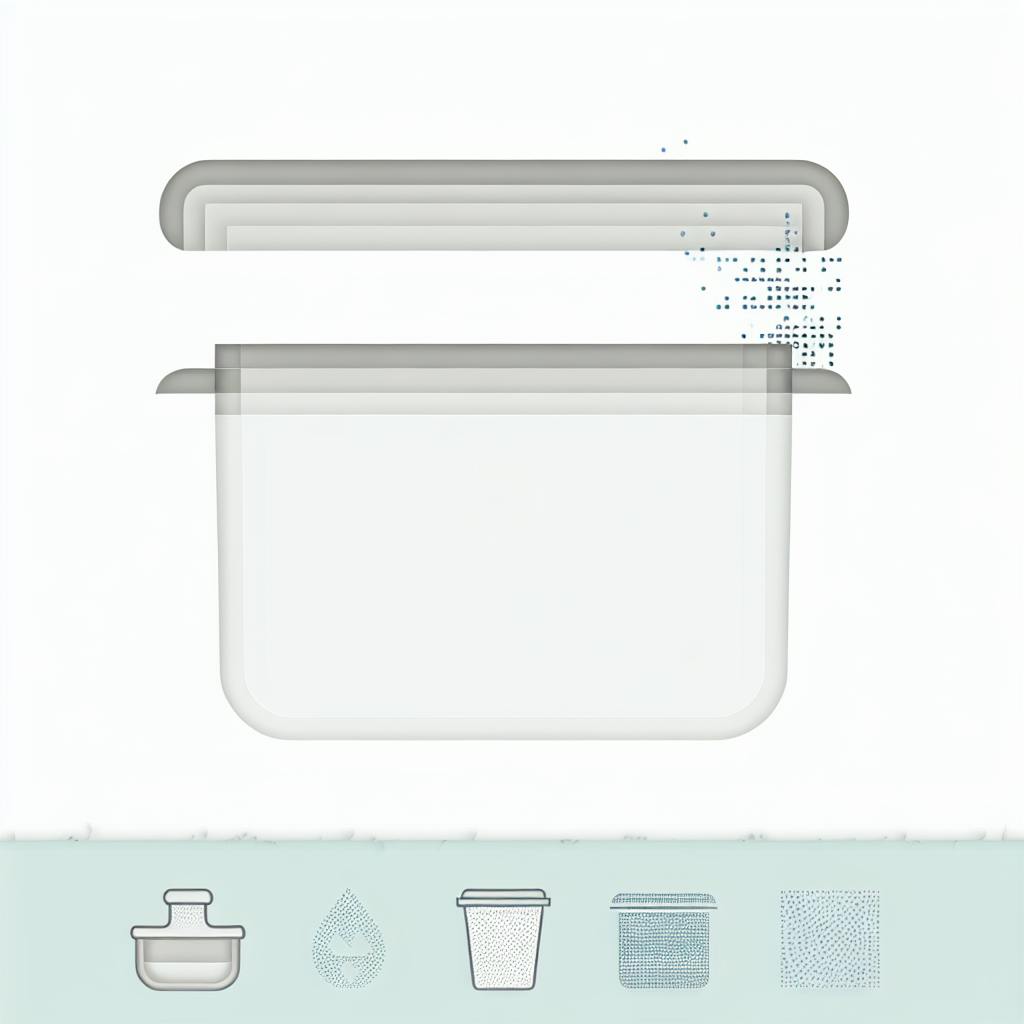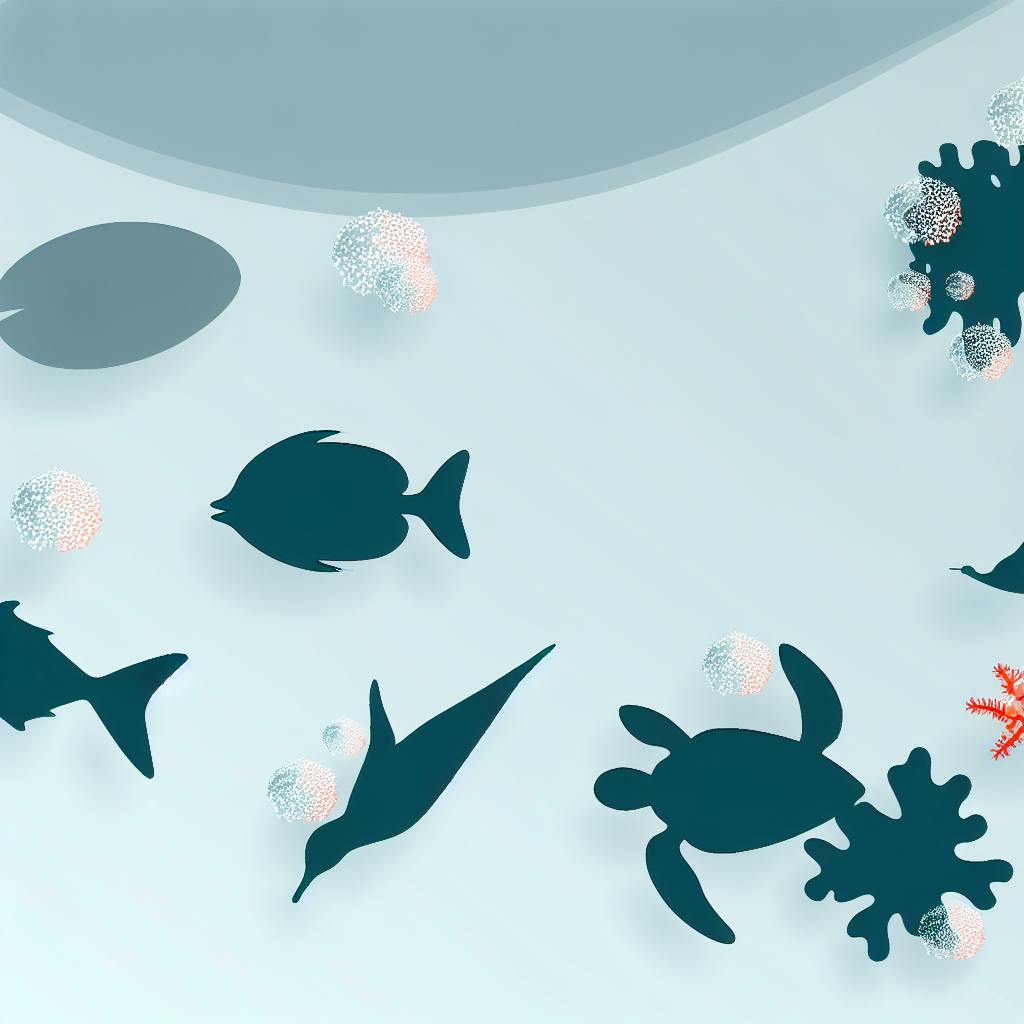Microplastic pollution is a growing environmental concern threatening ecosystems and human health. ISO 24187 provides guidelines for sampling, sample preparation, and data processing to accurately analyze microplastics in the environment.
Key Points
- Microplastics are plastic particles < 5 mm in size from sources like cosmetics, clothing, and plastic debris.
- ISO 24187 aims to ensure microplastic analysis is accurate, comparable, and reliable.
- It defines particle size classifications:
| Size Range | Classification |
|---|---|
| < 1 μm | Nanoplastics |
| 1 μm - 1 mm | Microplastics |
| 1 mm - 5 mm | Large microplastics |
- Sampling guidelines include using appropriate filtration, drying samples below 40°C, and following existing environmental sampling standards.
- Analytical techniques outlined include Raman spectroscopy, pyrolysis-gas chromatography-mass spectrometry (py-GC/MS), and Fourier transform infrared spectroscopy (FTIR).
- Best practices involve robust sampling, sample preparation, analysis methods, quality control, and detailed reporting.
By following ISO 24187, researchers can generate reliable data to better understand and address microplastic pollution's impacts on the environment and human health.
Understanding ISO 24187: Scope and Definitions

ISO 24187 provides a framework for analyzing microplastics in environmental matrices. To ensure consistency and accuracy in microplastic analysis, it's essential to understand the scope and definitions outlined in the standard.
Scope of ISO 24187

ISO 24187 focuses on analyzing microplastics in:
- Water
- Sediment
- Biota
The standard provides guidelines for:
- Sampling
- Sample preparation
- Data processing
Definitions and Size Classifications
ISO 24187 defines microplastics as particles with a size range of less than 5 mm. The standard introduces a particle size classification system, categorizing microplastics into different size ranges.
| Size Range | Classification |
|---|---|
| < 1 μm | Nanoplastics |
| 1 μm - 1 mm | Microplastics |
| 1 mm - 5 mm | Large microplastics |
Objectives and Limitations
The primary objective of ISO 24187 is to provide a standardized approach for microplastic analysis, enabling researchers and environmentalists to generate reliable and comparable data.
Limitations:
- ISO 24187 does not provide a single approach to testing.
- The standard outlines several analytical methods and provides general guidelines for sampling, sample preparation, and data processing.
By understanding the scope, definitions, and objectives of ISO 24187, researchers and environmentalists can ensure that their microplastic analysis is consistent, accurate, and reliable, ultimately contributing to a better understanding of microplastic pollution and its impacts on the environment.
Preparing for Microplastic Sampling
When preparing for microplastic sampling, it's crucial to follow key principles to ensure the accuracy and reliability of the analysis. According to ISO 24187, having a large enough sample volume is vital to examine a sufficient mass and/or number of particles.
Sample Volume and Filtration
The smaller the expected number of particles, the larger the volume needed. Additionally, using appropriate filtration processes is essential. For instance:
- Drying samples: The temperature should not exceed 40 °C to prevent degradation of the microplastics.
- Filter materials: Use plastic-free materials to avoid contamination.
Existing Environmental Sampling Standards
Existing environmental sampling standards, such as:
| Standard | Matrix |
|---|---|
| ISO 5667 series | Water, sediment, and sludge |
| ISO 23611 series | Soil |
| ISO 16000 series | Air |
can be used as a basis for sampling, but should be modified for microplastic analysis where necessary.
By following these guidelines, researchers and environmentalists can ensure that their microplastic sampling is accurate, reliable, and consistent, ultimately contributing to a better understanding of microplastic pollution and its impacts on the environment.
Analyzing Microplastics: Techniques and Selection
Microplastic analysis involves various techniques to identify and quantify microplastics in environmental samples. ISO 24187 outlines several analytical methods, including Raman spectroscopy, pyrolysis-gas chromatography-mass spectrometry (py-GC/MS), and Fourier transform infrared spectroscopy (FTIR). Each technique has its strengths and limitations, and the choice of method depends on the research objectives and sample characteristics.
Analytical Techniques
The following table summarizes the analytical techniques, their strengths, and limitations:
| Technique | Strengths | Limitations |
|---|---|---|
| Raman Spectroscopy | Non-destructive, detects a wide variety of plastics, particularly useful for identifying microplastics in the 1-10 μm size range | Does not provide direct quantification, affected by fluorescence from inorganic materials |
| Pyrolysis-Gas Chromatography-Mass Spectrometry (py-GC/MS) | Destructive, provides direct quantification, detects particles as small as 0.4 μm | Limited capability to detect different polymers, does not provide information on particle size |
| Fourier Transform Infrared Spectroscopy (FTIR) | Non-destructive, detects a wide variety of plastics, provides information on particle size and morphology | Does not provide direct quantification, affected by interference from water |
When selecting an analytical technique, researchers should consider the research objectives, sample characteristics, and the advantages and limitations of each method. By choosing the most suitable technique, researchers can ensure accurate and reliable results that contribute to a better understanding of microplastic pollution and its impacts on the environment.
sbb-itb-1dc3f59
Applying ISO 24187 in Microplastic Research
ISO 24187 provides a framework for analyzing microplastics in environmental samples. To apply this standard, it's essential to understand its principles and guidelines. Here, we'll discuss key considerations for implementing ISO 24187 in microplastic research.
Robust Analytical Methods
ISO 24187 emphasizes the importance of using suitable analytical methods to identify and quantify microplastics. Researchers should select methods that fit their research objectives and sample characteristics. The standard outlines several analytical techniques, including:
| Technique | Description |
|---|---|
| Raman Spectroscopy | Non-destructive, detects a wide variety of plastics |
| Pyrolysis-Gas Chromatography-Mass Spectrometry (py-GC/MS) | Destructive, provides direct quantification |
| Fourier Transform Infrared Spectroscopy (FTIR) | Non-destructive, detects a wide variety of plastics |
Each technique has its strengths and limitations, and researchers should carefully consider these factors when selecting a method.
Quality Control and Assurance
Quality control and assurance are critical components of microplastic analysis. Researchers should establish quality control procedures to ensure the accuracy and reliability of their results. This includes:
- Calibrating instruments
- Using certified reference materials
- Implementing quality assurance protocols
ISO 24187 provides guidelines for quality control and assurance, which researchers can use to develop their own protocols.
Inter-Laboratory Comparisons
Inter-laboratory comparisons are essential for ensuring the credibility of microplastic research. ISO 24187 recommends that researchers participate in inter-laboratory comparisons to validate their methods and results. This involves comparing results with other laboratories using the same methods and samples.
By following the principles and guidelines outlined in ISO 24187, researchers can ensure that their microplastic research is accurate, reliable, and credible. This standard provides a comprehensive framework for analyzing microplastics, and its implementation is critical for advancing our understanding of microplastic pollution and its impacts on the environment.
Best Practices for Microplastic Analysis
To ensure accurate and reliable results in microplastic research, it's essential to follow best practices in sampling, sample preparation, analysis, and reporting.
Sampling
When collecting samples, consider the following:
- Sample volume: Ensure a large enough sample volume to examine a sufficient mass and/or number of particles.
- Filtration: Use appropriate filtration processes to prevent contamination.
- Existing standards: Modify existing environmental sampling standards (e.g., ISO 5667 series for water, sediment, and sludge) for microplastic analysis where necessary.
Sample Preparation
When preparing samples, remember:
- Avoid affecting plastics: Choose sample preparation procedures that do not affect the plastics in the sample.
- Drying: If drying is performed, keep the temperature below 40 °C.
Analysis
When selecting analytical methods, consider:
- Suitable techniques: Choose methods that fit your research objectives and sample characteristics.
- Technique strengths and limitations: Be aware of the strengths and limitations of each technique, such as Raman Spectroscopy, Pyrolysis-Gas Chromatography-Mass Spectrometry (py-GC/MS), and Fourier Transform Infrared Spectroscopy (FTIR).
Reporting
To ensure transparency and reproducibility of results, provide detailed descriptions of:
- Sampling and analysis methods: Include any quality control and assurance procedures implemented.
- Results: Present results in a clear and concise manner.
By following these best practices, researchers can ensure that their microplastic research is accurate, reliable, and credible, ultimately advancing our understanding of microplastic pollution and its impacts on the environment.
Conclusion: The Role of ISO 24187 in Microplastic Research
ISO 24187 plays a crucial role in advancing microplastic research by providing a standardized approach to microplastic analysis. This article has highlighted the importance of following best practices in sampling, sample preparation, analysis, and reporting to ensure accurate and reliable results.
International Collaboration and Standardization
The development of ISO 24187 marks a significant step towards international collaboration and standardization in microplastic research. As the first official standardized method for microplastic analysis, it sets a precedent for future research and paves the way for more effective monitoring and management of microplastic pollution.
Advancing Our Understanding of Microplastic Pollution
By adopting ISO 24187, researchers and environmentalists can contribute to a broader understanding of microplastic pollution, ultimately informing policies and practices that mitigate its effects on the environment and human health. As the global community continues to address the challenges of microplastic pollution, the importance of standardized methods and international collaboration cannot be overstated.
FAQs
What is the ISO standard for microplastics?
The ISO standard for microplastics is ISO 24187:2023. This standard provides guidelines for analyzing microplastics in the environment. It defines microplastics as solid plastic particles that are:
- Insoluble in water
- Have at least one dimension between 1 μm and 1,000 μm
Additionally, it defines "large microplastics" as solid, insoluble plastic particles with any dimension between 1 mm and 5 mm.


